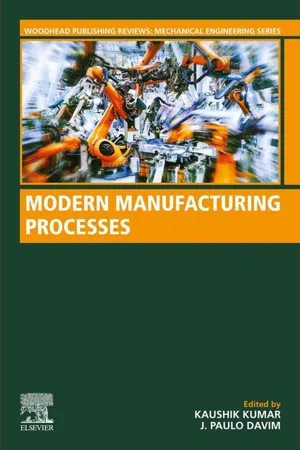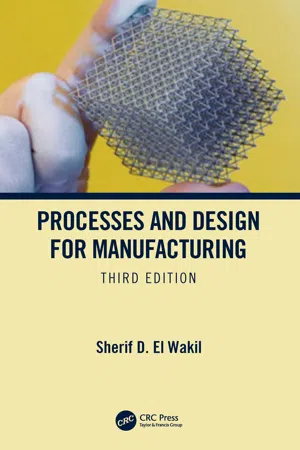Composite Manufacturing Methods
Composite manufacturing methods refer to the processes used to create composite materials, which are made by combining two or more constituent materials with significantly different physical or chemical properties. These methods include techniques such as hand lay-up, filament winding, and resin transfer molding, and are used to produce strong, lightweight, and durable components for various applications in industries such as aerospace, automotive, and construction.
3 Key excerpts on "Composite Manufacturing Methods"
- eBook - ePub
Design and Manufacture of Plastic Components for Multifunctionality
Structural Composites, Injection Molding, and 3D Printing
- Vannessa Dr Goodship, Bethany Middleton, Ruth Cherrington(Authors)
- 2015(Publication Date)
- William Andrew(Publisher)
...3 Composites: Manufacture and Application Bethany Middleton Abstract Composite manufacturing covers a broad range of materials, manufacturing methods, and application areas. This chapter considers manufacturing routes, their applications, and research trends. It also looks at the limitations of composite manufacture and drivers for multifunction. Keywords multifunctionality composite composite manufacturing self sensing self reinforcing hybrid composites 3.1. Introduction Composites consist of two or more distinct phases, and although they make up a single material, the components remain individually recognizable and separable. The constituents that form the composite material must be present in reasonable proportions, say greater than 5%, and be dispersed uniformly among each other. By combining two (or more) different materials, the resulting composite benefits from the properties of the two constituent phases, and has properties not achievable by individual constituents (Thomas et al., 2012). Most composite materials generally comprise two phases, a continuous matrix combined with a dispersed reinforcement. There is a wide range of matrix and reinforcement materials resulting in a vast number of composite combinations, each with differing properties and benefits. Although metal and ceramic matrix composites exist, this book focuses on polymer matrix composites (PMCs). PMCs are often used as lightweight metal replacements and have the advantages of being lightweight, stiff, and strong, and generally have lower manufacturing costs when compared to metals. Considering the huge range of potential polymer matrix materials that can be combined with a number of different reinforcement types, which themselves can be arranged in various different architectures, the range of PMCs becomes apparent. Before multifunctional aspects can be explored, it is necessary to introduce the properties of composites and their manufacturing methods...
- eBook - ePub
- Kaushik Kumar, J. Paulo Davim(Authors)
- 2020(Publication Date)
- Woodhead Publishing(Publisher)
...Section 1 Advances in Manufacturing Processes Outline Chapter one Advanced manufacturing techniques for composite structures used in aerospace industries Chapter two Advances in manufacturing analysis: fractal theory in modern manufacturing Chapter one Advanced manufacturing techniques for composite structures used in aerospace industries Raghu Raja Pandiyan Kuppusamy 1, Satyajit Rout 2 and Kaushik Kumar 3, 1 Department of Chemical Engineering, National Institute of Technology, Warangal, India, 2 Department of Civil Engineering, National Institute of Technology, Warangal, India, 3 Department of Mechanical Engineering, Birla Institute of Technology Mesra, Ranchi, India Abstract This book chapter focuses on different liquid composite molding techniques that have been adapted to manufacture aerospace composite structures. At first, introduction to polymer matrix composites, resin matrices, and reinforcement fiber are presented. In the following sections, possible composite processing methods are reported. In the subsequent section, an introduction to molding techniques is discussed. Finally, manufacturing of epoxy–carbon composite laminate through primitive hand lay-up technique to advanced resin transfer molding techniques are detailed. Keywords Resin transfer molding; compression molding; vacuum bagging; VERTMTy; VARIM 1.1 Polymer matrix composites Composite materials are produced by stitching dissimilar materials that have diversified properties. The constituent materials function as whole unit that offers composite material of unique properties. Composites are made up of one continuous phase and one or more discontinuous phase. The discontinuous phases are mixed and uniformly distributed over the continuous phase. The continuous phase is called matrix. The material rigidity, environmental resistance, and hold up of discontinuous phase are the main functions of matrix. Metals, polymers, and ceramics can be used as matrix material...
- Sherif D. El Wakil(Author)
- 2019(Publication Date)
- CRC Press(Publisher)
...9 Characteristics, Fabrication, and Design of Composites 9.1 Overview A composite can be defined as a material made up of two (or more) identifiable materials (or phases), combined usually in an ordered fashion to provide specific properties different from and superior to those of the individual materials. Those two materials that constitute any composite are referred to as the matrix and the reinforcement. It is customary to classify composites based on the nature of their matrix materials. Based on that classification, there are three main groups: polymer-matrix, metal-matrix, and ceramic-matrix composites. Most naturally occurring structural materials such as timber are, in fact, composites. Moreover, the merits of crude forms of composites have been known for centuries; for instance, straw-reinforced clay was reportedly used as a building material in Egypt in 1500 BC. It is only in the past 60 years that composites—and fiber-reinforced polymers in particular—have become important engineering material. New synthetic high-strength, high-modulus fibers and new resins and matrix materials have elevated fiber-reinforced composites into the material of choice for innovative lightweight, high-strength engineered products. These developments, along with established engineering design criteria and special processing technology, have advanced fiber-reinforced composites close to the realm of a commodity material of construction. In the areas of automobile bodies, recreational boat hulls, and bathtubs and shower stalls, fiberglass-reinforced organic polymer resins have indeed become the material of choice. In more advanced applications, the first completely fiber-reinforced polymeric resin composite aircraft, the Boeing 787, came into existence in the 1980s and is now widely used by various airlines...


